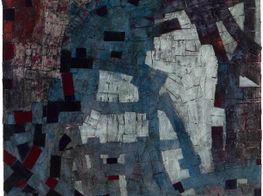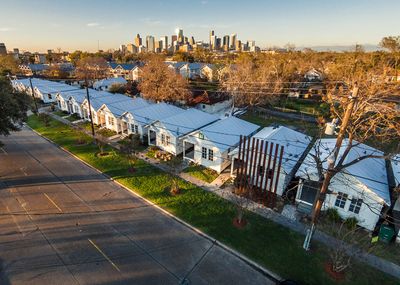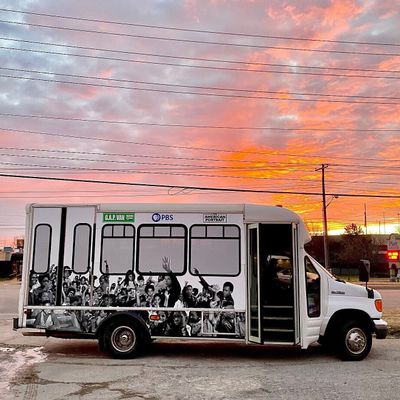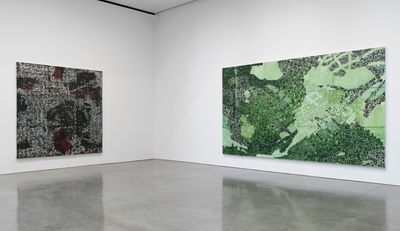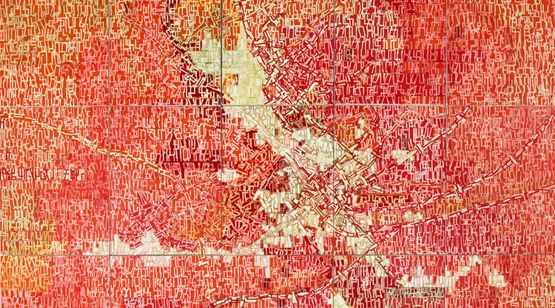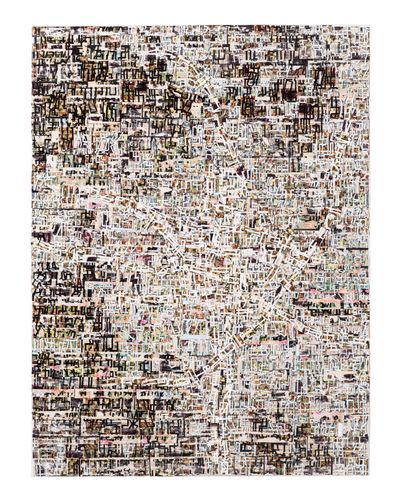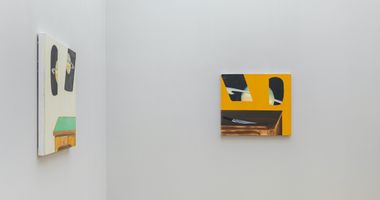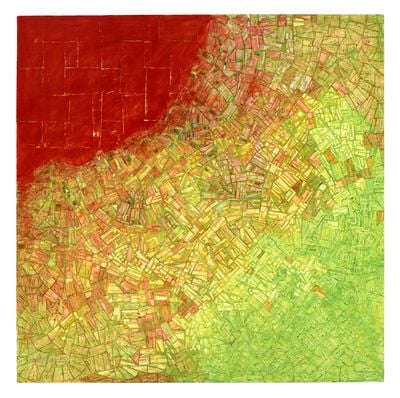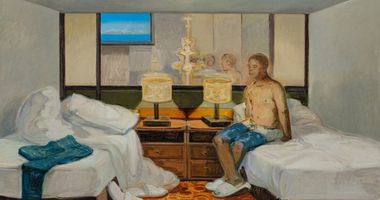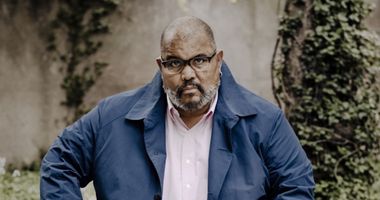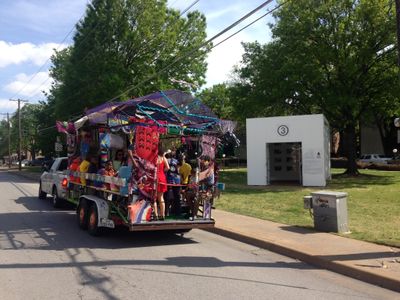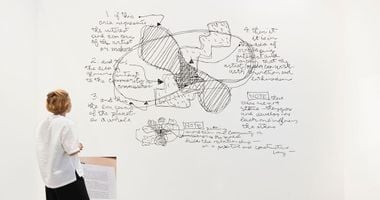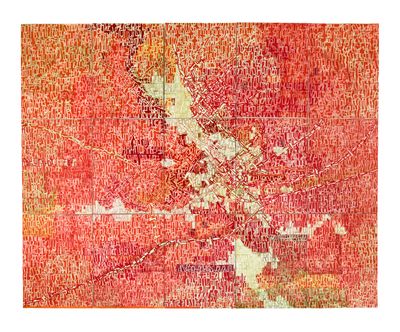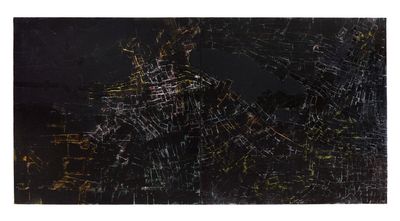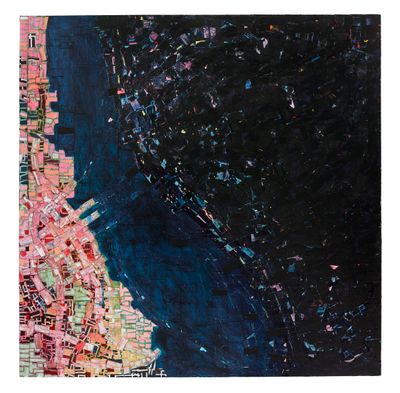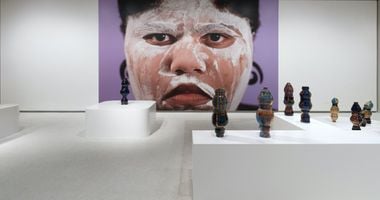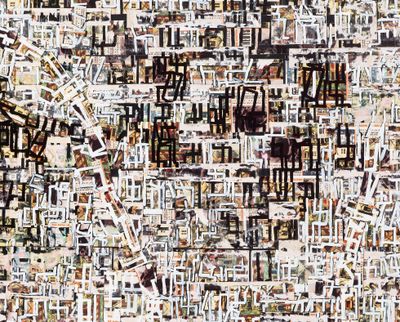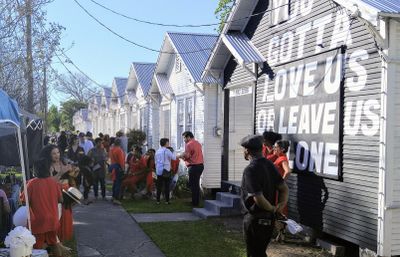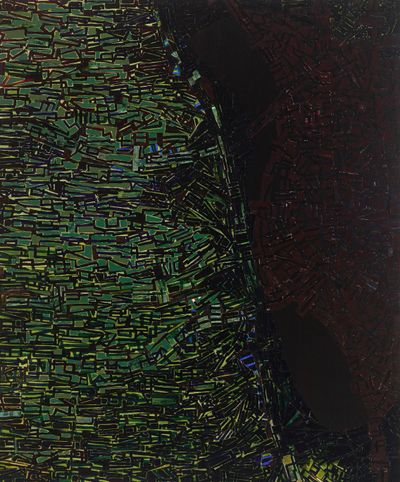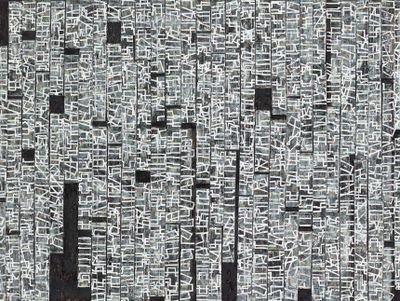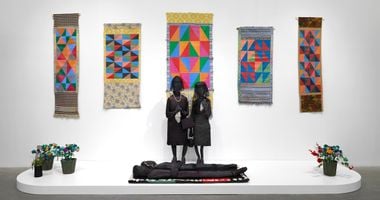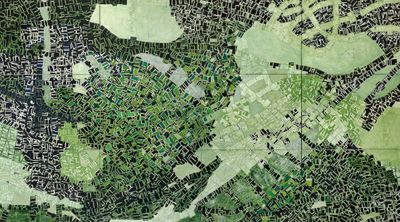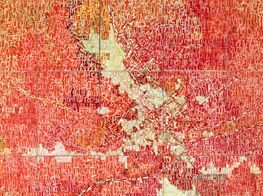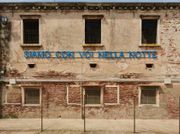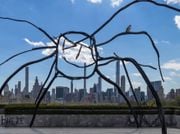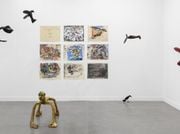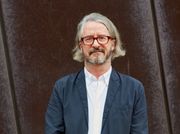Rick Lowe’s Meditations on Social Sculpture
Rick Lowe. Courtesy the artist and Gagosian. Photo: Brent Reaney.
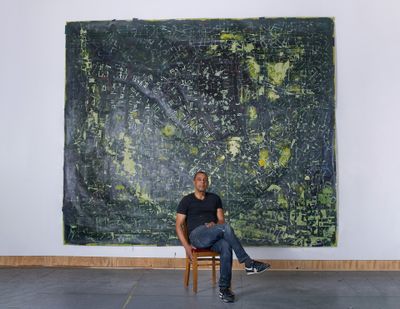
Rick Lowe. Courtesy the artist and Gagosian. Photo: Brent Reaney.
Rick Lowe is best known for projects like Project Row Houses, which Lowe founded with six Black American artists in 1993: James Bettison, Bert Long, Jr., Jesse Lott, Floyd Newsum, Bert Samples, and George Smith.
Twenty-two derelict shotgun houses spanning a block-and-a-half of Houston's Third Ward, where B.B. King once played at the Eldorado Ballroom, were renovated to host community programmes exploring how art might facilitate conditions for social transformation.
Project Row Houses has grown to encompass 40 properties across six blocks, with exhibition and artist residency spaces, offices, a community gallery, a park, low-income residential and commercial spaces, and houses made available to young mothers for one year.
Other projects have followed, including Greenwood Art Project in Tulsa, Oklahoma (2018–2021). Working with local artists, Lowe developed public installations commemorating the 1921 Tulsa Race Massacre, when a thriving Black community living in the Greenwood District, an area known as 'Black Wall Street', was destroyed.
The Tulsa Race Massacre forms the basis of Black Wall Street Journey (2021–ongoing). This city-wide activation focusing on the histories of Black wealth-building in communities across Chicago with public art projects and programmes was presented as part of Toward Common Cause: Art, Social Change, and the MacArthur Fellows Program at 40 at the Smart Museum of Art in 2021.
Lowe's Black Wall Street study is extended in his upcoming show at Neubauer Collegium for Culture and Society, University of Chicago. Notes on the Great Migration (25 October 2022–10 February 2023) will explore the movement of millions of Black Americans from the South to North of the United States between 1916 and 1970.
Lowe describes his community projects as social sculpture, which involves working with a cross-section of society, from artists and local business owners, to national institutions, and state and municipal bodies.
His unique approach to community work led to his engagement with documenta 14 in 2017, launching the Victoria Square Project in downtown Athens with Greek artist Maria Papadimitriou. Located in a vacant shop near Victoria Square, an informal centre for the European migrant crisis of 2015, the community space organises art workshops and programmes supported by Stavros Niarchos Foundation and Allianz Kulturstiftung.
After nearly three decades, Lowe is reflecting on the questions raised by his projects through painting. As with his social sculptures, Lowe approaches the material composition of painting intuitively.
Ahead of Notes on the Great Migration, Lowe is staging Meditations on Social Sculpture, an exhibition of abstract, map-like paintings at Gagosian in New York (8 September–22 October 2022). Paintings featured relate to Project Row Houses (1993–2018) and Victoria Square Project (2017–ongoing), with newer compositions reflecting on the conceptual implications of working communally.
Each of these paintings, Lowe has said, are objects of memory. Project Row Houses: Biggers and Beuys (2021), for example, is named after two significant influences for Project Row Houses: Dr John Biggers, an artist and educator who lived in the Third Ward, and Joseph Beuys, who coined the term 'social sculpture' in the 20th century.
Amazingly, Meditations on Social Sculpture is Lowe's first solo exhibition in New York, where one of his paintings is currently on view in the 2022 Whitney Biennial. The 16-panel black-and-white grid evokes both city plans and maps, and the dominoes that Lowe has used to engage with communities and compose his geometric works.
Its title, Project Row Houses: If Artists Are Creative Why Can't They Create Solutions (2021), commemorates the trigger that has defined the course of Lowe's lifework. In this conversation, Lowe describes this turning point of his practice, while reflecting on how his paintings connect with his social sculptural work.
SBProject Row Houses was your point of entry into social sculpture, but painting is where your practice really started. How did painting become a point of return in your Gagosian show?
RLPainting is familiar because it's something that I started out in, but it's also very different for me this time because of all the life experiences I've had and the different ways that I've practised. So going back into painting now, I'm arriving at some place very different, which plays a completely different role in terms of my need and desire to creatively utilise the medium.
SBIs it true that you were originally a landscape painter?
RLYes, correct. I started in a very conservative manner of painting landscapes and still life. But that had more to do with the limitations of the school I was attending, which was a very small, conservative, traditional school.
Of course, I'm grateful for the opportunity I had to explore the technique of painting, and the teachers were great for helping me understand the role of painting in the world. But the traditional subject matter was not for me. So I immediately started to move around and into figurative work.
SBThere's a painting on view at the Whitney Biennial, Project Row Houses: If Artists Are Creative Why Can't They Create Solutions. Would you say this work marked a departure from the canvas, into the real world?
RLAbsolutely. It was a critical time for me because I had been making very didactic paintings dealing with political and social issues throughout the 1980s, and I kind of hit a peak.
I did an installation about police brutality in 1989 in response to two police killings in Houston, where I lived, and built this public exhibition around them. There was such a great response from folks in the community; it was on the front page of all the local newspapers and all the television stations.
So I thought I was where I needed to be, until this student came and pulled the rug out from under me. He challenged me, saying, 'If you're an artist and you're creative, why can't you create solutions?' It made me question whether painting could even address the kind of issues that were central to my concerns. So that was my departure from that.
SBThe painting is a black-and-white mapping of networks that unfolded intuitively, which connects to how you've described working with communities as an intuitive process.
Critics often negate projects like yours based on their quantifiable success in effecting change. We forget that a social sculpture is an artwork that resides in the realm of the symbolic and the poetic; one that is also generative.
Thinking about the role intuition has played in your work, how has your understanding of your social sculptures evolved through painting about them?
RLThe work is always intuitive and I generally find myself in an explorative process of asking questions. As I am making a painting, I am trying to deal with the question that was put before me when I started doing social practice and social sculpture works.
There's pressure nowadays for art to play this role of solving problems in a traditional way.
I'm trying to reflect on the value of social practice—what it's meant to me, to the field of artistic practices, to communities, and so on. What guided my thinking around that painting, in particular, was how I had spent nearly 25 years working with communities, trying to make work that had practical application.
And after 25 years, I'm looking back and I'm still questioning: do I really understand it? Because you can't measure a social sculpture the way you measure social services—it doesn't work that way. So that piece is really about articulating the mystery of the value of art—the solutions that art actually brings, even if they're not the solutions we're generally aiming for.
Art can provide a solution of inspiration—vision, possibilities, and transformation for viewers in the world, but it doesn't have all the solutions for solving homelessness or police brutality.
I don't know if we have the language to truly articulate the value that art brings now, and there's extreme pressure nowadays for art to play this role of solving problems in a traditional way. We have to figure out this language. Otherwise, we allow ourselves to be in a position of having to explain the value of our work based on criteria that are better served for social services.
SBYou've said that you hope communities feel like they're actively involved in the production of their place through your projects.
To create the conditions for that, you materialise an idea with the potential to have a life beyond you, which is similar to how artworks operate. Do you view your social sculptures this way?
RLAlways. Artists may have their idea of what they intended for their work and what they infused into it, but when people view a painting, they bring their own observations and start to complete the work from their own experiences.
SBIn a conversation with David Adjaye and Thelma Golden, you talked about space and place. You said that people can deal with the idea of space because it's an abstraction, but place is harder. It's where sociological webs intersect and people don't necessarily know how to handle that.
This opens up a way to look at your paintings and social sculptures as acts of placemaking. There's a whole discourse around abstract painting as a meditation on space, but your paintings are abstractions rooted in the places where these abstractions materialised.
RLThat's a very astute observation. It's important to me that there is a connectedness to a place in the paintings that I make, so having some element of that place in each painting becomes a part of that process of placemaking.
You can't measure a social sculpture the way you measure social services.
So there's the physical manifestation of bringing in folk elements from the community; the domino-playing and the symbols I'm pulling from drawings that I make of them. It's about trying to layer the work with a kind of authenticity of a place, but it's not just about this. There's also a deep appreciation for the act of painting in the work, and a lot of thought goes into the formal aspects of the painting itself, and the spatial plane.
SBIt feels like your paintings are conduits, since you work from an intuitive space to articulate a sense of place, which recalls the game of dominoes.
Playing dominoes not only informs the composition of your paintings, but acts as a means to connect with the communities you work with. Dominoes are a threshold into a place, effectively.
RLWhat's really funny in the space of community and the creativity that flows from playing dominoes together is the wisdom of the players, the language, and all this stuff that comes out around the table. You just reminded me of a term that I should use more, from one of my mentors, whom I often played dominoes with: dominology.
There is a dominology of taking these drawings—cutting them apart, and creating this language that is about the surface, the environment, the place, and the clicking of the sounds. All that for me is brought right into these works.
I go back and forth. Sometimes I allow the work to move itself and develop into a more refined surface. And then I have to back myself up and try to get back some of that grittiness that I carry with me from the places that I want to bring into the work.
SBDominology is such a great way to think about how your social sculptures evolved, because the game of dominoes is effectively a system-building exercise that is both intuitive and responsive. It's always an interaction between players.
RLAbsolutely. There are many layers of domino-playing from people who play a lot and at the highest level. There are the rules of the game and the memorising of the plays—so you can have people who are really good at all that. But then you can have somebody who also has this kind of intuitive dominology that just makes it impossible to beat them.
So that kind of intuitive building of things that you see as a domino table, I definitely bring that into these paintings because I collect information as I'm working. The piece at the Whitney, for instance, started as straightforward, flat, kind of hieroglyphic-looking symbols, but I brought in a couple of things for this mapping, and just started following where the dominos land.
SBWhen making these paintings, do you begin with a place in mind, with your materials, archival documentation, and images in front of you, and then see where your hands take you?
RLAbsolutely. For the 'Black Wall Street Journey' series, I would start with these fake 100-dollar bills and see where that led me.
In projects like Project Row Houses and Victoria Square Project, I'm dealing with colourful photo archives. I print them out and collage them, which begins to dictate the colour of the paintings.
But I don't set out to do so. If I have photos that are mostly yellow or whatever, I don't decide that a painting is going to be yellow. A painting may start with a base of that yellow, but it depends on the colours that go on top of that. I'm just responding to that initial moment.
SBSo you are moving with the form and colour that unfold in front of you and responding to the painting's compositional balance as it evolves?
RLIt's a spiritual journey for me to try to bring these projects into the paintings. While people might not see it, as a maker, I'm pulling as hard as I can and in every direction to bring these things in.
Not everything that went into putting together the projects is visible on the surface—maybe ten percent is. For me, that is symbolic of the ephemeral projects I've worked on; there are so many things, people, and moments that go into making a social sculptural project that get lost over time.
When I say the surface, I mean the forefront of people's minds when they think of these projects. What remains under the surface is the foundation. It's the same with the paintings—much of the history of these projects is embedded as the foundation and there may be glimmers of it on the surface, but not a lot.
SBYou mentioned the ephemerality of your community projects, which connects to how you look at your paintings as memory objects. You've called your 'Black Wall Street Journey' paintings archival documents that insist on keeping the memory of Black Wall Street and the Tulsa Race Massacre alive.
But this ephemerality also relates to how you date your projects. There's an end date for Project Row Houses, which signifies you stepping back from a project that now operates as its own entity. Whereas the Victoria Square Project is ongoing.
How do you determine the timelines for your social sculptures?
RLI struggled with this idea of when a project begins and when it ends. Even the beginnings are not as clear as we make them historically. Most people will say Project Row Houses started around 1993, when the first group of volunteers came in. Others will say 1994, when it opened to the public.
My artistic imprint on the project had an end to it. But the project continues and it has its own identity as an institution.
But I could date it to 1992, when it was in my head and had no physical manifestation—but it was there. Likewise, when a project comes to an end, when is that? So I decided that the end would be for me, not the project.
My artistic imprint on the project had an end to it. But the project continues and it has its own identity as an institution. It's great, but as an art project that I'm actively working on, within the context of what I'm trying to do as an artist, it's no longer there. With the Victoria Square Project, it's getting to a similar scenario.
SBWith your U.S. projects, there's a connection between you and the communities you work with; but how did it feel going into Athens?
RLIt's a very similar scenario. I showed up in a place at a moment when there was this incredible tension between the locals and all the immigrants and refugees coming into the city. In that sense, it was very similar to the situation with Black people in America. There was a narrative that was wrapped around the refugees and immigrants that were coming into Athens that encouraged and bred fear and xenophobia.
So with that project, it was about finding a way to generate a different narrative so that people could see these people coming into the city as assets—people with something to offer.
Of course, we know that most didn't have anything to offer from an economic standpoint. But what we understood was that there was a cultural value within those populations that could have an incredible impact on the city if there was room to show what was possible.
There was so much hostility in that neighbourhood, particularly from shopkeepers and store owners, toward the refugees and immigrants. So much tension.
But then the Victoria Square Project popped up with all these activities, actions, and events, which ranged from performances of traditional Greek songs and African dance, to a Georgian fashion show. It was a movement of different things, and it's ongoing, which shows the possibility of community.
SBTension is a keyword. Your social sculptures mediate a cross-section of society, with people who do not necessarily align in vision or politics. This can be quite tricky to navigate. How do you do it?
RLWe have conservative people, liberal people, radical people, fascist people; all kinds of people. But I always like to think that none of those positions is necessarily carved in stone. People are fluid. We have to create opportunities for people to shift direction.
Someone in Athens said they wouldn't work on the Victoria Square Project any longer, because I was looking to engage this particular restaurant owner who they said is a supporter of the Golden Dawn fascist party in Greece.
I didn't know this. But I told this person about how this project is trying to generate a better understanding of the cultural diversity in Athens, and that person became one of the project's lead organisers because he'd been in the neighbourhood for so long and knew so many people.
Then I found out he was labelled a Golden Dawn supporter because Golden Dawn people ate at his restaurant, and he was like, 'Look, all kinds of people come in here, you know?' That's just one example of why it's really important for people to say who they are and show how they want to be involved.
My approach is to allow people to bring their best to the project. I start by establishing what a project is about and making sure that whoever seeks to engage with it has some sense of commitment to that. This will weed out the people who aren't interested.
SBYou must have so much inner strength to mediate these relations!
RLThe thing is, I just love the work. I grew up in a working family, and one thing that I'll never forget is that the work is important. That's the main thing. I feel rewarded, every day. That's why I continue to do it.
SBYou've said that your work is about trying to open a different perspective, and with Black Wall Street Journey, this has to do with resisting stereotypes and remembering moments in history when Black America thrived.
This expanded view brings to mind W.E.B. Du Bois' Visualising Black America project, which he showed at the World's Fair in Paris in 1900. It included these detailed mappings of class diversity in Georgia.
This connects to critiques that come up around community art projects, about art parachuting in and participating in a neighbourhood's gentrification. How do you respond to these critiques?
RLFor me, the Black Wall Street Journey project was really about trying to figure that out, and it is very good of you to mention that about Du Bois—he understood that there was something else going on in Black America that people needed to know.
And similarly, looking at Black Wall Street in the context of the Tulsa Massacre, it was very important to look at this incredible spirit of building. But not too many people were leaning towards that, because people find a certain kind of comfort in looking at the destruction of things and people.
So this idea that we could point people toward this moment in time, which spoke to the heart and the character of Black people, was missing. I wanted to show that, not only from a historical standpoint, but to put it in the framework of a journey.
And that journey continues. Even to this day, there are many great things that are happening. Of course, these great things are not happening at the level, in a broad sense, that we'd like to see, but we have to honour those struggles and the people who are defeating the odds—they're making incredible histories. The sad part is that there is no narrative around that.
This is a story of Black wealth in a capitalist society where there is lots of Black wealth, but it does not serve the many who still live in poverty.
The narrative around Black people is one of deficit. There's little narrative about the assets of Black people, and the goal of Black Wall Street Journey was to really talk about this. Because we know about the deficits. We live them all the time.
This all goes back to that question of artists creating solutions. When that high school kid asked me that question, he said: 'We know what the problems are. We live with them all the time. But where are those solutions?'
Where are those places where we can find empowerment and inspiration? How can we move forward and continue this journey of developing economic well-being for Black people? There has to be a narrative around that so that it's available.
SBI wanted to touch on the intersection of class and race in the Black Wall Street Journey. You commemorate a community that gamed the system that chronically exploited them, so it would work for them, but there were still class divisions, which returns to Du Bois' visualisations at the turn of the 20th century.
RLThe economic question of Black Wall Street is one that is absolutely puzzling for me. When I was making paintings before, they were very didactic and had very specific political angles to them, because the world at that time was black and white for me. But as I've gotten older, I've started to see the complexity of things, and one of the things about Black Wall Street Journey is that it is very complex.
There was a class situation there. It was very liberal within that community, but there was no patronage—it was much more about familial distributions of wealth, but not in an equitable way.
In my current work, it's like walking a line between trying to gain an understanding of this moment and elevating it, and recognising its complexity. This is a story of Black wealth in a capitalist society where there is lots of Black wealth, but it does not serve the many who still live in poverty.
SBYou showed the Black Wall Street Journey in Towards a Common Cause in Chicago, and you're returning to Chicago in October with Notes on the Great Migration, which extends the Black Wall Street Journey project. Could you speak about that?
RLI'm actually from Alabama, and this goes back to my childhood and that experience of being in Alabama. There was this migration that was happening at the time; many of my aunts and uncles had migrated to Chicago and Detroit.
That movement was part of the Black Wall Street Journey of seeking better economic conditions. Obviously there was the part of moving away from the racial hatred that was rampant throughout the South, but it was also about going towards economic opportunity.
The Black Wall Street Journey is still trying to find its way within one of the neighbourhoods on Chicago's South Side. I thought I would add another layer to that and bring in my connection to this notion of a Black Wall Street, which manifests itself in the context of the Great Migration.
SBYou've said anything could be social sculpture, which relates to the Tulsa Massacre as something you've argued that white America has to contend with, too. That massacre contributed to the Great Migration, which speaks to your point about communities being fluid and shifting, and to dominoes as well, because every move is a response.
I wanted to bring this back to your show at Gagosian, which positions these paintings, your meditations on social sculpture, as an opportunity to think about the issues of equity and urban planning in a more conceptual way. How have these paintings helped you think through those issues?
RLIt became an opportunity to regenerate my understanding of social sculpture. One of the challenges of doing community-engaged work is that you get wrapped up in it, and the resources around it are so few that you have to maximise what you can bring.
But those resources are generally you, so you just maximise yourself. You find yourself so embedded in the context that you never get to reflect. These paintings are an opportunity to breathe, refresh myself, and think about what I've learned, what I understand, and what I don't.
There's struggle in these paintings. They're fighting to find knowledge and understanding.
I don't have great ambitions about transforming people, but I do hope that people look at these paintings and get a sense of the struggle in them. I'm struggling and trying to understand what it all means, and I'm passing that struggle to whoever gets to see these paintings.
We share the responsibility to try to better understand the systems that shape urban contexts—all these things that are impacting us. It's not my responsibility as the artist to solve these issues, nor is it the responsibility of the people in those communities. We all have to bring something to it.
The hope is that people will sense that these paintings are not crystal clear about what happened, what didn't happen, or what needs to happen. There's struggle in these paintings. They're fighting to find knowledge and understanding. Hopefully that energy comes through. —[O]

